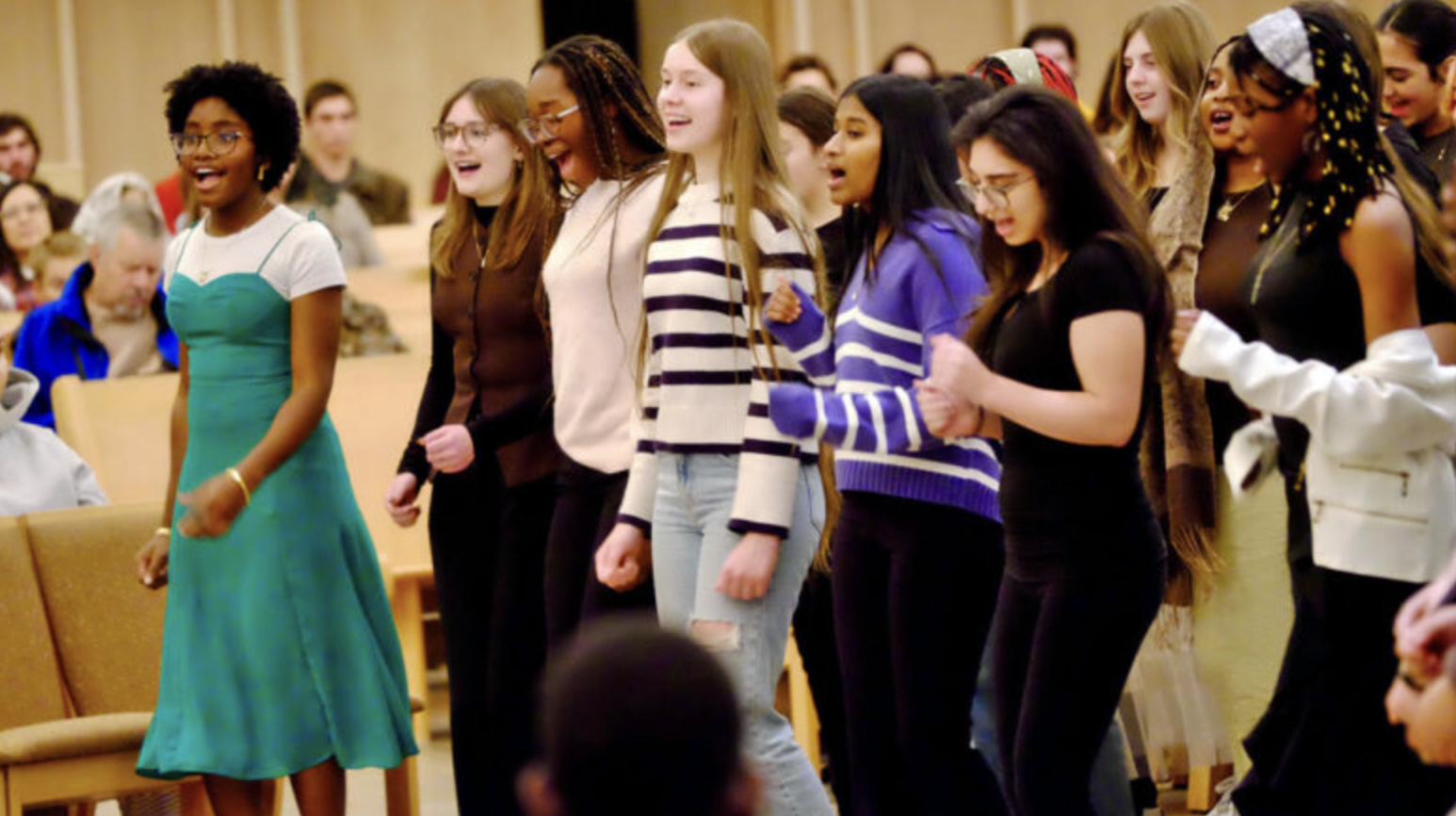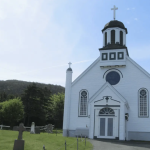SASKATOON, Sask. (CCN) — Hundreds filled the Cathedral of the Holy Family in Saskatoon Oct. 21 for an introduction to St. Carlo Acutis, the 15-year-old “millennial saint” who was canonized this September, known for his devotion to Jesus Christ and for his love of the Eucharist.
A time of music, witness, and Eucharistic adoration in the worship space was followed by an exhibit in the hall featuring large panels detailing some of the Eucharistic miracles documented on a website created by the young saint before he fell ill with acute leukemia and died in 2006.
Organized by the St. Joseph Catholic High School Community Council in partnership with the Cathedral of the Holy Family, the evening program began with a welcome and overview from MC Diane Murza of St. Joseph Community Council. “No matter where you are in your faith journey, this evening is for you,” Murza told the students, families, parishioners, and visitors who gathered for the event.
“The Eucharist itself is a miracle that we encounter every time we come to Mass, when the bread and wine is changed into the body and blood of Jesus, but when we refer to a Eucharistic miracle, we are referring to a really extraordinary event,” Murza explained. These include cases where the Eucharist no longer appears as bread and wine, but takes on biological qualities of human flesh or blood, as well as other miracles involving the multiplication of hosts, or the appearance of a face.
“These types of miracles are quite rare, but the more modern ones have been scientifically verified and this helps us see how the invisible becomes visible, and confirms our faith,” Murza said.
St. Joseph High School Choir under the direction of Sean Bzdel opened the program with several selections, followed by an overview of the life of St. Carlo Acutis, presented by diocesan Evangelization and Mission Leader John Hickey.
Life of St. Carlo Acutis
Carlo Acutis was born in London, England on May 3, 1991 into a well-off Italian family that moved to Milan, Italy a few months later. His parents were not devout Catholics, and his mother Antonia said she only attended Mass a few times before her son was born. “But Carlo’s curiosity and early questions about God, the saints, and the Eucharist stirred something in his family. His hunger for truth led them back to the Church,” said Hickey.
“From a young age, Carlo showed signs of spiritual maturity and deep empathy,” he added, but at the same time, he was “a regular kid” who loved soccer, played video games and had a house full of pets.
“He also had a heart tuned to the suffering of others,” said Hickey, sharing accounts of young Carlo’s care for classmates going through difficulties, and his outreach to homeless people he met in Milan.
“Despite being tech-savvy, Carlo had a clear sense of balance. He limited himself to one hour of video games per week, saying, ‘I don’t want to waste time on things that don’t lead me to God,’” Hickey recounted.
“He often said, ‘All people are born as originals, but many die as photocopies.’ His goal was to live life well – authentically – and close to Christ,” Hickey described.
“Carlo attended daily Mass from age seven, he prayed the Rosary every day, and he made Eucharistic Adoration a regular part of his life. He said, ‘To always be close to Jesus, that’s my life plan.’ He believed that the Eucharist was his ‘highway to heaven,’ and he often encouraged others to receive the Eucharist regularly.”
Young Carlo observed that while people would line up for hours to attend concerts or soccer matches, they “won’t spare a few minutes for Jesus in the Eucharist.”
“That disconnect stirred something in him,” Hickey said. “Carlo wanted people to rediscover the beauty and mystery of the Eucharist. So, at just age 11 years old, he began to research Eucharistic miracles, documenting events where the consecrated host visibly transformed or was preserved in miraculous ways. He spent four years compiling these miracles and he built a website, designing it himself to be accessible and engaging. His goal was simple: to help people fall in love with Jesus in the Eucharist.”
The website, www.miracolieucaristici.org, has since been translated into multiple languages and displayed in thousands of parishes and universities across five continents, Hickey observed. “It’s a testament to Carlo’s belief that technology, when used well, can be a powerful tool for evangelization. Through this project, Carlo showed that holiness isn’t about escaping the modern world… it’s about transforming it. He used his gifts to bring others closer to Christ, and in doing so, he became a bridge between our traditional faith and modern life.”
At age 15, Carlo was diagnosed with acute leukemia, offering his suffering for the Pope and for the Church. He died on Oct. 12, 2006, and on Sept. 7, 2025 was declared a saint of the Catholic Church.
“St. Carlo Acutis reminds us that holiness is possible in everyday life. He didn’t wait to be older, richer, or more influential. He used what he had – his faith, his computer skills, and a joyful heart – and he used those things to bring others closer to Christ,” said Hickey, adding that his life is not meant simply to be admired, but to be emulated. “I can only imagine if every single one of us here could follow his example, and what that could do for your school, your parish, and this city.”
Impact of encountering St. Carlo Acutis
Two young adults also spoke about the impact of St. Carlo Acutis on their own lives.
University of Saskatchewan student Julia Nazar took part in a diocesan young adult Jubilee pilgrimage to Italy in May that included visiting the tomb of Blessed Carlo Acutis in Assisi.
“Sometimes God meets us in ways we don’t see coming, not in thunder or in grand signs but in single unforgettable moments. This past summer, I had an experience that changed the way I see holiness,” said Nazar of the visit to view the body of the young saint.
“The moment I saw him lying there – a young man dressed in a hoody, jeans, and sneakers – I was absolutely lost for words,” she said. “ It wasn’t like seeing a distant, historical saint… it felt like encountering someone I could have sat next to in class, someone I could have been friends with. My heart honestly just wanted to reach in and give him a hug and tell him ‘You did it.’”
She added: “What struck me most was how normal he looked, and yet how powerfully God worked through his life.”
Nazar reflected how Carlo used the Internet to bring people closer to Jesus, seeing it as more than a place of trends and distractions, but “as the mission field” and a way to spread the Gospel and inspire people to love Christ.
“God can use the everyday tools that we have – even something as simple as a social media post – to touch hearts and change lives,” she said. Carlo’s life shows that “holiness isn’t far away, and it isn’t reserved for people who lived centuries ago. It is something that God calls us to now in our ordinary lives with the gifts we have been given… God can work through us too. Holiness isn’t about being perfect: it’s about saying yes to God’s plan, even when we don’t fully understand it.”
Rylan Boursa described how his friendship with St. Carlo Acutis grew through a Catholic Christian Outreach mission trip to be part of a team hosting the “Blessed Carlo Acutis Centre” at a church in Rome during the Jubilee of Youth July 29-31, 2025, which included the opportunity to venerate a first class relic of Blessed Carlo Acutis (taken from the membrane surrounding his heart).
The CCO missionaries had two goals in hosting the centre in Rome during the Jubilee, Boursa said: “to engage in conversation and prayer with pilgrims who came into the church in the hope of fostering a deeper conversion to Christ-centredness, and to spread awareness about Carlo Acutis as his canonization was approaching.”
“We were accompanied by a priest Monsignor Anthony Figueiredo who first gave a talk at Assisi where Carlo’s body lay… then while in Rome, Monsignor would speak to pilgrims from around the world about the life of Carlo, and so over those few days I got to know and hear about Carlo a lot.”
Boursa credits the young saint with leading him to a deeper devotion to Christ in the Eucharist. “When on mission I heard the quote from St. Carlo: ‘The Eucharist is my highway to heaven.’ I could not get that out of my head… Carlo had such a love and devotion to Christ in the Eucharist. I think about that quote daily now.”
In prayer before the relic throughout the mission, Boursa asked Blessed Carlo to help him grow in faith and reverence toward the Eucharist, and later in Adoration before Jesus in the Blessed Sacrament he said that he was blessed to see the image of a mystical face: an experience which continues to resonate. “When I received the Eucharist on that Sunday morning, something was different. My heart changed and I truly felt the power of Christ at work within me… I attribute these things in my life to the influence of St. Carlo Acutis.”
Describing St. Carlo as “a powerful intercessor and a wonderful friend of mine in heaven,” Boursa said he has come to more clearly understand the role of saints. “Carlo, through his example and his intercession, pointed me towards God, and then he stepped into the background.”
Thanking the speakers, and all those who contributed to the celebration, to the exhibition of Eucharistic miracles as designed by St. Carlo Acutis, and to the reception that followed, MC Diane Murza also noted the “divine timing” of an event long in the planning that had happened earlier in the day: a Eucharistic procession brought the Blessed Sacrament from the cathedral to the chapel at St. Joseph High School, where it will now remain with the permission of the bishop. “We are so grateful for that,” she said.
Eucharistic adoration
Introducing a time of Eucharistic adoration, Murza urged all those present to not be hurried. “Be open to wonder and take time to encounter Jesus, and in a personal and intimate way experience his love for you.”
Fr. Gerard Cooper placed the Blessed Sacrament on the altar in a monstrance as those assembled spent time in adoration, with worship music led by Matthew Marcoux and Maria Gursky.
The exhibit of materials designed by St. Carlo Acutis followed in the parish hall, where large panels gave a sampling of a few of the miracles featured on the website he established to help people fall in love with Jesus in the Eucharist.




